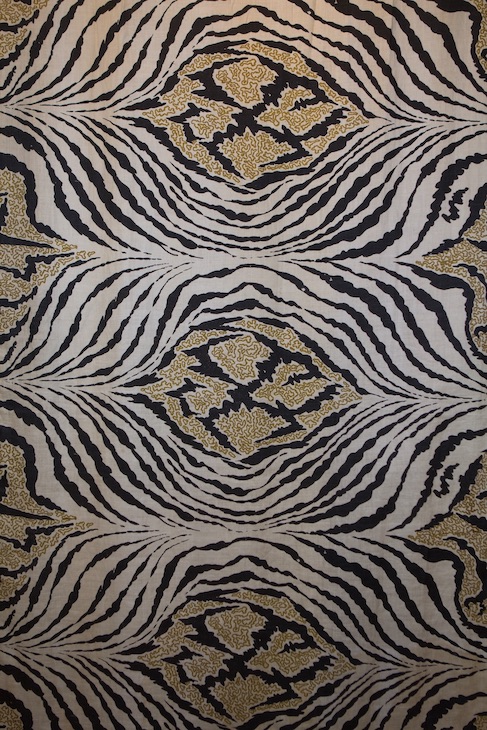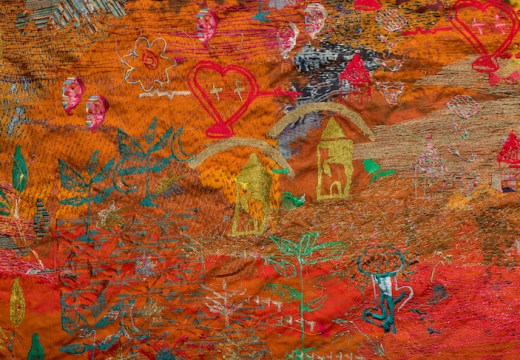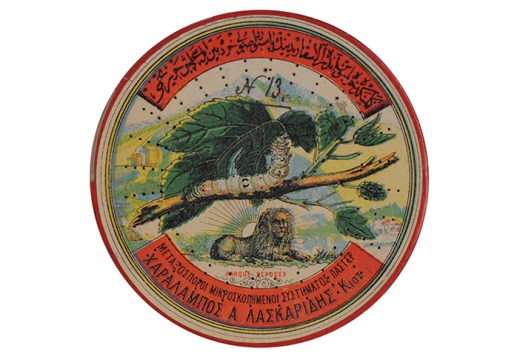You can almost imagine the moment the sole wore through – in a forest, surrounded by beech trees perhaps, or high on a mountain path with the valleys dividing below – when rock and scrub finally came in contact with skin. Then again, it may have been at the end of the day when, tired from the distance covered and eager for the evening meal, she inspected the shoe and discovered the hole. Yet, having ‘tramped many miles’ in her pair of hide and twine opanke – peasant shoes worn in the Balkans – Edith Durham (1863–1944) tramped some more.
Included in the exhibition ‘Unbound’ at Two Temple Place, which focuses on the textile collections of seven women, Durham’s well-worn shoes tell a double story – of the item’s provenance and of the collector – which depends on our ability to imagine context from details. Of the soles that were oiled and moulded to better grip rocks underfoot we envision the lives of countless other opanke wearers, glimpse the region’s terrain and grasp the qualities prized in their fabrication. Of this particular pair, we understand a little of the irrepressible woman who dedicated much of her life to the Balkans and its people – writing seven books on the region, teaching herself Serbo-Croatian and at various times distributing quinine, noting regional funereal customs, visiting monasteries and mosques, collecting song cycles and ballads or reporting on the local effects of multinational treaties.

Giubba (19th century), Albania. Bankfield Museum, Halifax. Photo: Calderdale Museums Collection, Halifax
It is slightly unusual for a collector to include an item they used so extensively in their own collection. Walter Benjamin, writing with fond humour about his library, stated that his ‘failure to read these books’ (for which he suffered the privations of pawnshops and expended many hours seeking out editions in catalogues and auctions) marked him out as a true collector. By contrast, Durham and the six other women in this exhibition were not in the business of merely accumulating rarities. The common feature of their vast and varied collections, now publicly held, is their interest in items disregarded and undervalued. If, as Jean Baudrillard wrote, every object has two functions – ‘to be put to use and to be possessed’ – these seven collectors proved they were able to simultaneously appreciate practical function and identify overlooked worth.
For Louisa Pesel (1870–1947), whose collection of textiles and embroidery was built around her desire to understand the frayed histories of different kinds of stitch, practical usage went beyond the item itself and into pedagogic, therapeutic and economic activity. A vitrine which holds pages from her sewing guide illustrates different stitches for use on satin, and details instructions for a square chain stitch alongside a pinned-on example in vibrant orange. After graduating from the Royal College of Art she was appointed designer and then director of the Royal Hellenic School of Needlework and Lace in Athens, which was established in 1897 to provide training for refugee women fleeing the Greco-Turkish War. Having returned to Bradford in 1907 to care for her sick mother, she taught embroidery to Belgian refugees and shell-shocked soldiers during the First World War, sharing her knowledge in an attempt to improve and enrich shattered lives. On the opposite wall hangs an altar frontlet stitched by soldiers of the Bradford Khaki Handicrafts Club.

Curtain with jungle repeat pattern (n.d.), Enid Marx. Compton Verney, Warwickshire. Photo: Harminder Judge
Muriel Rose (1897–1986) shared a similarly benevolent impulse, bringing attention to Britain’s many ‘exceptionally gifted’ and often anonymous craftsmen in the years between the wars. Believing firmly in the worth of traditional and contemporary craftsmanship, and in addition to her gallery’s regular exhibitions – of ‘ethnic’ crafts such as Mexican rugs, and fabrics designed by a new wave of textile artists including Ethel Mairet, Elizabeth Peacock and block-printers Phyllis Barron and Dorothy Larcher – Rose lent her support to quilters in colliery towns across Wales and the north of England, regions hit especially hard by the depression. Photographs of the stark conditions in which quilters lived and worked are shown next to two immaculately stitched tea cosies resembling ecclesiastical headwear.
While the pieces on show demonstrate usefulness, they also appeal aesthetically and are often full of humour. A section devoted to Rose’s contemporary Enid Marx (1902–98) includes a chaise longue strikingly upholstered in block-printed velvet and a dazzling ‘jungle’ print. It looks like a zebra crammed into a kaleidoscope and drizzled with egg yolk. In the skylit stairwell hang three long banners of indigo-dyed hemp by the Japanese artist Hiroyuki Shindo, whose studio in the village of Miyama also houses a tiny indigo museum. The gradations of transparency are an elegant foil to the balls of thread below which appear to have sprung alive from the marbled floor.

Brocade shoe without clog (1735–45), unknown maker. Chertsey Museum. Photo: John Chase Photography; © The Olive Matthews Collection, Chertsey Museum
Where Benjamin characterised ownership as ‘the most intimate relationship one can have with objects’, Baudrillard was blunt: ‘What you really collect is yourself.’ Both, in a sense, are correct. How can we ever experience the thrill Olive Matthews (1887–1979) must have felt in securing a pair of 18th-century brocade shoes for a bargain at the Caledonian Road market? What satisfaction must Louisa Pesel have felt in finding an example of Cretan embroidery that showed the distinctive needlework’s plurinational origins? The items that survive these collectors bear the traces of their taste and times, which join, but do not overwrite, those left by their existence prior to acquisition.
The final room is dedicated to pieces collected by curators Jennifer Harris for the Whitworth Art Gallery in Manchester and Nima Poovaya-Smith for Cartwright Hall in Bradford. Dominating the room is Alice Kettle’s monumental embroidered triptych Three Caryatids (1988–89), whose figures bear the ghostly weight of the hours spent working their individual stitches. As one of the first large-scale pieces Harris acquired for the Whitworth, the triptych set the scope of her ambitions for the gallery’s collection of textile art. Poovaya-Smith, by contrast, grew Cartwright Hall’s collection by acquiring pieces reflecting on the history of cultural exchange and colonial rule, particularly that of the local area. Next to two contemporary saris commissioned by Poovaya-Smith from British-Asian artists Fahmida Shah and Sarbjit Natt hangs a traditional Punjabi phulkari embroidered with exquisite care in floss silk. Evident between the flowing lines of the luxurious saris and the jaunty birds and grinning dogs on the hanging are the breaks and continuities involved in the diasporic embrace of contemporary and traditional practices.
Harris and Poovaya-Smith have insisted on the importance of textiles in ways that shape present and future notions of what is missing from museum collections, what is worth attention, what should be collected. And, as shown by the addition of a sack-back gown to Olive Matthew’s collection at the Chertsey Museum and the anticipated gift of a wedding dress from an Albanian resident in Halifax (where Durham’s collection now resides), these collections, of which ‘Unbound’ showcases but the smallest portions, continue to grow. Writing about saris in 1992, Poovaya-Smith noted: ‘Tradition and innovation are the two ingredients needed for the continuing life of this most beautiful of textiles.’ Her words are relevant to textiles beyond saris. By being handed on and handed over, by stimulating ‘intelligent experimentation’ and having their significance made visible to the public, they take on yet another kind of story.
‘Unbound: Visionary Women Collecting Textiles’ is at Two Temple Place, London, until 19 April 2020.
Unlimited access from just $16 every 3 months
Subscribe to get unlimited and exclusive access to the top art stories, interviews and exhibition reviews.














![Masterpiece [Re]discovery 2022. Photo: Ben Fisher Photography, courtesy of Masterpiece London](http://www.apollo-magazine.com/wp-content/uploads/2022/07/MPL2022_4263.jpg)
It’s time for the government of London to return to its rightful home